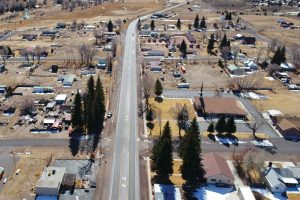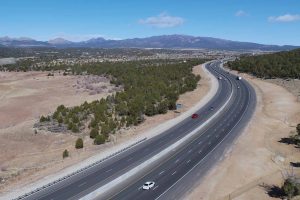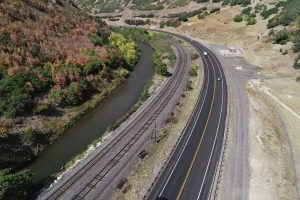By The Utah Asphalt Pavement Association
What are UDOT’s long-term plans regarding our state’s infrastructure?
As opposed to the what, I like to start with the why. It’s UDOT, sure — but there’s so much more to the equation, which includes our suppliers, our vendors and our affiliates. Why do we all exist?
The focus is on quality of life. We exist to enhance the quality of life through transportation. Better mobility improves health, reduces air pollution, and connects people to places and to each other. Better mobility strengthens our economy. When all this works, it allows the economy to thrive. That’s our goal, every day. That’s the why of our existence.
Now for the what. What do we need to do to accomplish the big why? Just recently, we’re eyeing a $1.5 billion national legislature appropriation bill to improve our nation’s infrastructure, preserve our roads and optimize mobility. As a state and as a country, these are the three things: improve, preserve and optimize.
While all three things are important, we are very focused on maintaining our roads and keeping our pavement in good condition. We need to take care of our stuff — it costs less in the long run. As a state, we need to be wise stewards of taxpayer funds and their allocation.
Roads are the arteries through which our economy pulses and they are vital to any community development agenda.
Utah is growing — a lot. What are your thoughts on how best to manage our transportation needs?
A lot of people look at growth in two ways: a problem or a challenge. Given what we do here at UDOT and what I personally have done for my entire career, I look at growth as an opportunity.
Where we are as a state in regards to growth is a great place to be. Imagine the problems we would have if we were not growing. However, we need to think about how we grow.
We think of ourselves as westerners. We like space, but with growth comes urban problems. Interestingly, 65% of Utah is owned by our government — state and federal. We have roughly 25% of our state available for growth, and 90% of Utahns live in an urban area. When it comes to growth planning, I think it’s important to recognize that we are an urban state with a large recreation area, so we are densely populated.
Thirty-five years ago, when I started my career with UDOT, we had less than 1 million people living in Utah, and now we have 3 million. We can’t double the mileage use of our roads. It’s not feasible.
Our land-use decisions need to be informed. How many homes per acre? What’s the density? Should we build higher? Should we be building closer to high-capacity corridors? We need to be thinking about truly multi-modal transit. Here in Utah, it’s still one car and one person for the majority of the ways we travel.
We need more people using active transportation, such as walking and biking. I believe that we need to have more Utahns use public transit for commuting.
We are actively building new roads and widening existing roads. We have ongoing plans to design, construct and maintain our roads, but I also believe we need to be more active in optimizing the existing structures.
We are also focused on managing traffic better and more efficiently. Because of our investment in fiber optics at our traffic operations center in our Region 2 office, we know in real time how many vehicles are stopped on red at various locations, which means that we can more effectively handle signal management. Or crash management, which means that we can inform people and divert them to other routes.
Additionally, we’re going to have to embrace technology, which for our state, is probably not a concern. For instance, a Utah company is working on inductive chargers in pavement. That would mean charging EV batteries while driving. This is pretty exciting technology that involves smart technology and pavement. It’s a ways out, of course, but Utah is at the forefront of finding solutions to the problems that we will face in the near future as we grow.
It’s been interesting to see the statistics of the past year, and more importantly, to identify any longer-lasting trends that came from what we did to contain the virus. The reality is that I don’t think we can emerge from the year the same as we were before.
What are some of the “wins” for UDOT in the past couple of years, and how do you see those plans benefiting the state in the future?
Wins can be hard to measure. We continue to work hard at earning the public’s trust. Trust is our currency. We win it by doing what we say we are going to do. We don’t overpromise and underdeliver.
I believe that UDOT has demonstrated that “trust currency” in the recent actions of the legislature. We’re receiving a boatload of one-time money coming from the bulk of our state surplus.
We have a lot of projects — big needful projects — that our transportation committee has spent well over two and a half months reviewing and budgeting for, and now we’re here. We’re ready, and we’re going to be busy.
With the pandemic this past year, many people worked from home. When all these people go back to work, what do you see as the effect, and how do you think this should be managed?
It’s been interesting to see the statistics of the past year, and more importantly, to identify any longer-lasting trends that came from what we did to contain the virus. The reality is that I don’t think we can emerge from the year the same as we were before.
I think the people that couldn’t work from home took on the largest burden.
Last April we saw a 40% decline in traffic. That’s a big drop. We’re now in the low 90% of returning traffic, so we’ve recovered by traffic statistics. In looking back at 2020 overall, we saw a 20% decline in gas tax revenues.
UDOT has always had a goal in place of having 30% of our workforce working from home. We want to reduce office space, commute times and air quality. This past year gave us the opportunity to test that initiative, and overall it went well. Of the 30% that we identified as being able to work from home, 40% now are.
We saw some other things. In 2020 there was a significant drop off from transit. Some people worked from home, of course, so that drop off was understandable. But we also saw some people that didn’t work from home and used to take public transit use their cars to commute.
I believe that lessons were learned last year and I believe that those lessons will impact our traffic management in better ways. I believe that more people will work from home than before and that in and of itself will impact the amount of traffic on the roads at any given time, as people will have more flexibility in when they are on the roads.
How does Utah’s infrastructure compare to other states?
We’re in very good condition. We’re fortunate in that our government leaders understand the importance of infrastructure. We have capacity projects scheduled. We take care of our roads.
We raised the gas tax in 2016 — indexed it to the CPI — and it all went into pavement and some bridges. Pavements are our largest infrastructure asset — $24 billion of replacement value. Our bridges have a replacement value of $8 billion. Pavements are the most important thing we manage. We are fanatical about pavements.
With the reduced use of gasoline — especially with the rise of EVs — what do you think the effect will be on Utah’s roads? Since gas taxes pay for road maintenance, how will that be managed?
I think we need a usage-based tax, so we all pay for what we use. I think that is the fairest way to run a program. In 2020, Utah started a road usage charge program for EVs.
We currently have 3,000 people enrolled in our beta program, if you will. Currently, there are two such programs that are operational in the U.S. Oregon has one, and Utah has the other. We have a ways to go. It’s complicated with hybrids and EVs. The program itself is more for EVs, where owners of EVs have agreed to have a monitor in their car, and they pay for the miles they drive. There are several other states doing pilots. Utah and Oregon are up and running.
The idea has been discussed for 20 years. Oregon was the leader. The first gas tax was passed in 1918, and a lot has happened since then. We need to think about how we fund road usage. Gas tax revenue isn’t growing, and it’s not keeping up with funding transportation.
We’ve been working on this for a long time. The western states — Utah included — have been funding research projects for 10 years. We hired some private sector partners. It’s working — lots of learning opportunities.
We can’t be more thankful for the existence of UAPA, for what the association does and how they do it. Without the association, we would be working with 20 or 30 separate organizations, as opposed to the one voice of UAPA.
UAPA is, of course, focused on our roads. What can you say about the future of our roads that will be of interest?
There will always be a need for roads. For quality roads. The public wants smooth roads and roads that are in good condition. Finding solutions for longer-lasting pavements is a big thing. The public lives in a world of a new iPhone every two years and has little patience for things that take time.
We need to meet the demand for better pavements in a time-sensitive way that speaks to the quality and the best use of taxpayer dollars.
UAPA is celebrating its 10th anniversary this year. Why do you feel that UAPA is important to its members and the pavement industry as a whole?
We can’t be more thankful for the existence of UAPA, for what the association does and how they do it. Without the association, we would be working with 20 or 30 separate organizations, as opposed to the one voice of UAPA.
UAPA makes UDOT better; it’s as simple as that. I have known Reed Ryan, UAPA’s executive director, for a very long time, and he is an exceptional person. He cares about the industry, as do the members that have tirelessly served on the UAPA board and committees over the past 10 years.






